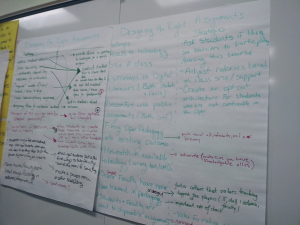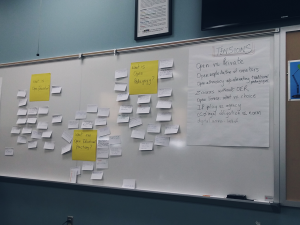Open Pedagogy Part 1 – What is the value of going ‘open’?
By Ashlee M. C. Foster, Instructional Design Specialist Oregon State University Ecampus

Are you committed to broadening access to education and knowledge, acknowledging and mitigating barriers, fostering social justice, and designing authentic and renewable learning experiences that contribute to the greater good? Do you employ pedagogical approaches that focus on student agency, collaboration, community, and connection to the public and world at large? If so, you may be an open educator at heart!
This is a three-part blog which will introduce the potential value of open pedagogy (part 1), critically examine considerations and strategies for implementation (part 2), and explore current practitioner examples and design approaches (part 3), which I hope will help you envision open assessments for your courses.
You may be thinking those two little words encapsulate a great deal, and you would be right! I have learned that this is a complex question with various evolving answers among practitioners. Recent literature indicates that there is a shift occurring from Open Educational Resources (OER) centered pedagogy to pedagogy that is focused on the potential impact, collaboration, connection, democratization of education, and the critical inquiry of systems and technology. Both leaders in the field, Robin DeRosa and Rajiv Jhangiani define open pedagogy as, “access-oriented commitment to learner-driven education AND as a process of designing architectures and using tools for learning that enable students to shape the public knowledge commons of which they are a part.” It may help to contextualize this pedagogy by examining your perceived value of the approaches, consider what excites you most, and identify how you personally connect with the pedagogy. Let’s begin by exploring this together!
What values underpin open pedagogy?

I had an invaluable opportunity to attend the Digital Pedagogy Lab Critical Open Pedagogy track, facilitated by Rajiv Jhangiani. Throughout the intense week, our cohort engaged in meaningful discussions centered on what is it that makes someone an educator, open pedagogical approaches, public scholarship, educational technology, the democratization of education, and how open pedagogy can foster social justice. Rajiv asked participants to review his 5Rs for Open Pedagogy and then write a personal interpretation of the values. Specifically, he asked, “What brings you (or others) to this work?” In the spirit of openness, I have shared my initial perception of the values which continue to evolve as I learn more about the field.
Recent literature surveyed educators and asked them to describe how going open impacts their pedagogical approaches. Educators indicated that the open approaches prompted them to find innovative ways for students to obtain and share knowledge, use of new methods and platforms, diversify learning materials to include multi-perspectives, actively teach open literacies, move to a participatory model of teaching and learning from one that was top-down, and to engage in critical inquiry around entrenched knowledge structures.
Additionally, educators shared their perceived value for creating learning assessments that:
- go beyond a single course (renewable),
- are broadly relevant (inclusive),
- allow for student choice when demonstrating learning (agency),
- connect to the real world and the learner’s personal interests (relevancy),
- amplify multi-perspectives from broad global voices (liberate),
- empower students with the knowledge and skills to participate openly (freedom), and for educators and learners to collaborate (participate)!
What are students saying?
These are valuable insights from practicing educators, but what are students saying about open approaches in their classes? In a recent study, 173 students were asked to compare the educational value of open pedagogy to traditional approaches, to identify the types of learning outcomes associated with this approach, and if they preferred open pedagogical approaches to traditional. Out of 169 respondents, 53% of students preferred open pedagogical approaches to traditional classroom teaching practices. Students shared that the open approaches led to increased knowledge of the material, synthesis of information, consideration for the relevance of information, how to bring information together in a meaningful way for diverse audiences, application to real-world issues which they personally connect with, and they found the approaches to be more engaging. However, 20% of students preferred traditional pedagogy. This highlights that the integration of varied approaches may be optimal. I have learned that open pedagogy is not necessarily a silver bullet that can remedy all barriers and challenges associated with closed systems. Rather, it seems to be a tool that can be leveraged to foster social justice, engagement, participation, collaboration, co-construction of knowledge, the democratization of education, and to increase global access to education.
With all that said, let us circle back around to the question posed in the Critical Open Pedagogy workshop, what brings you to this work? I encourage you to reflect on this question. You may even find it helpful to write out your interpretation of the values of open pedagogy and share those with the community. If you feel comfortable to do so, please feel free to share in the comments of this blog. Do you find yourself inspired by this pedagogical approach? If so, I invite you to revisit this blog for Open Pedagogy Part 2 – Critical Considerations for Implementation and explore the resources below.
References
- Hilton, J., Wiley, D., Chaffee, R., Darrow, J., Guilmett, J., Harper, S., & Hilton, B. (2019). Student Perceptions of Open Pedagogy: An Exploratory Study. Open Praxis, 11(3), 275–288. https://doi.org/10.5944/openpraxis.11.3.973
- Jhangiani, R. & Derosa, R. (2019). Open Pedagogy and Social Justice. Retrieved from https://www.digitalpedagogylab.com/open-pedagogy-social-justice/
- Jhangiani, R. & Derosa, R. (2017). Open Pedagogy in A Guide to Making Open Textbooks with Students. Licensed under Attribution 4.0 International (CC BY 4.0)
- Paskevicius, M. & Irvine, V. (2019). Open Education and Learning Design: Open Pedagogy in Praxis. Journal of Interactive Media in Education, 2019(1). https://doi.org/10.5334/jime.512
Resources
- DeRosa, R. (2017). Extreme Makeover: Pedagogy Edition. Retrieved from actualham
- Hodgkinson-Williams, C. & Trotter, H. (2018), A Social Justice Framework for Understanding Open Educational Resources and Practices in the Global South. Journal of Learning for Development. 5(3)
- Lalonder, C. (2017). Does Open Pedagogy require OER?
- Open Pedagogy Notebook – Sharing Practices, Building Community
- Reed, M. (n.d.). Subject and Course Guides: Introduction to Open Pedagogy: Examples. University of Texas Arlington UTA Libraries
- Teaching in Higher Education Episode 226 – Critical Open Pedagogy with Rajiv Jhangiani
- Wiley, D. (2007) The Four Rs of Open Content. Licensed under Creative Commons Attribution 4.0

